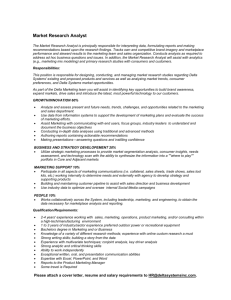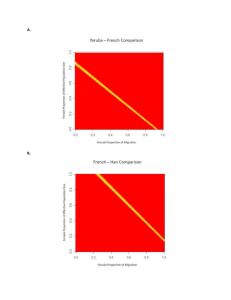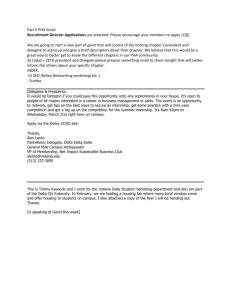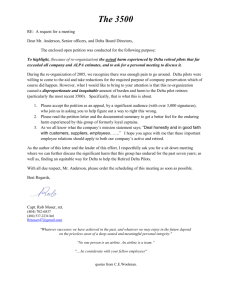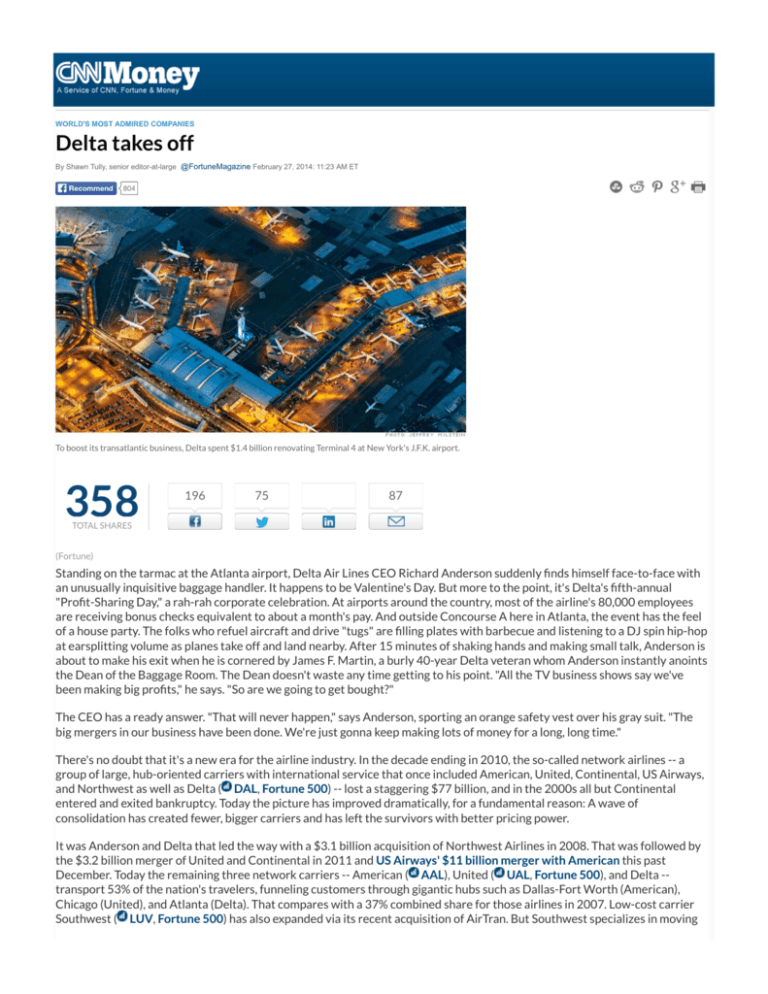
WORLD'S MOST ADMIRED COMPANIES
Delta takes off
By Shawn Tully, senior editor-at-large @FortuneMagazine February 27, 2014: 11:23 AM ET
Recommend
804
To boost its transatlantic business, Delta spent $1.4 billion renovating Terminal 4 at New York's J.F.K. airport.
358
196
75
87
TOTAL SHARES
(Fortune)
Standing on the tarmac at the Atlanta airport, Delta Air Lines CEO Richard Anderson suddenly finds himself face-to-face with
an unusually inquisitive baggage handler. It happens to be Valentine's Day. But more to the point, it's Delta's fifth-annual
"Profit-Sharing Day," a rah-rah corporate celebration. At airports around the country, most of the airline's 80,000 employees
are receiving bonus checks equivalent to about a month's pay. And outside Concourse A here in Atlanta, the event has the feel
of a house party. The folks who refuel aircraft and drive "tugs" are filling plates with barbecue and listening to a DJ spin hip-hop
at earsplitting volume as planes take off and land nearby. After 15 minutes of shaking hands and making small talk, Anderson is
about to make his exit when he is cornered by James F. Martin, a burly 40-year Delta veteran whom Anderson instantly anoints
the Dean of the Baggage Room. The Dean doesn't waste any time getting to his point. "All the TV business shows say we've
been making big profits," he says. "So are we going to get bought?"
The CEO has a ready answer. "That will never happen," says Anderson, sporting an orange safety vest over his gray suit. "The
big mergers in our business have been done. We're just gonna keep making lots of money for a long, long time."
There's no doubt that it's a new era for the airline industry. In the decade ending in 2010, the so-called network airlines -- a
group of large, hub-oriented carriers with international service that once included American, United, Continental, US Airways,
and Northwest as well as Delta ( DAL, Fortune 500) -- lost a staggering $77 billion, and in the 2000s all but Continental
entered and exited bankruptcy. Today the picture has improved dramatically, for a fundamental reason: A wave of
consolidation has created fewer, bigger carriers and has left the survivors with better pricing power.
It was Anderson and Delta that led the way with a $3.1 billion acquisition of Northwest Airlines in 2008. That was followed by
the $3.2 billion merger of United and Continental in 2011 and US Airways' $11 billion merger with American this past
December. Today the remaining three network carriers -- American ( AAL), United ( UAL, Fortune 500), and Delta -transport 53% of the nation's travelers, funneling customers through gigantic hubs such as Dallas-Fort Worth (American),
Chicago (United), and Atlanta (Delta). That compares with a 37% combined share for those airlines in 2007. Low-cost carrier
Southwest ( LUV, Fortune 500) has also expanded via its recent acquisition of AirTran. But Southwest specializes in moving
leisure travelers domestically, leaving the business market largely to the network triumvirate.
MORE: Most Admired Companies - the full list
The biggest winner so far in this post-merger world has been Delta. While its rivals are bound to get a boost from their
increased size and scope, they'll have to stretch to achieve the results Delta is posting right now. The profit figures tell the
story. With $37.8 billion in revenues in 2013, Delta actually trailed the sales of both the combined American and US Airways
($40.3 billion) and United Continental ($38.3 billion). But Delta earned a healthy $2.7 billion in profit -- an all-time record for
the industry. That compares with $2.15 billion in combined profits of American and US Airways last year and $1.1 billion for
United. Delta's 15% return on invested capital, based on the total of equity and debt, is the best in the industry, even surpassing
Southwest's. That financial strength has helped propel Delta onto this year's Most Admired Companies list for the first time at
No. 48 overall, and No. 1 among airlines.
Anderson's success at Delta is raising hopes in the industry that a network carrier has finally cracked the code for how to stay
consistently profitable. "The story of the airlines has been one of big financial losses," says Sir Richard Branson, president of
Virgin Atlantic, which recently formed a partnership with Delta. "Anderson is proving that the horrible yo-yo effect doesn't
have to keep repeating." That same prediction has been made before, of course, about other airlines and their leaders. But the
structural realignment in the industry raises the odds of success this time.
The outlook for passengers in this post-consolidation world might not be quite as rosy. When industry leaders boast that the
carriers are newly "rational" and "disciplined," they're really saying that fares will keep rising. "The airlines are pitching
seamless travel and more frequent-flier miles," says Richard Gritta, a finance professor at the University of Portland in Oregon.
"What customers will get is higher prices, tiny legroom, and packed planes." The industry rejoinder is that the larger carriers
will be able to move passengers more efficiently wherever they need to go around the globe. Furthermore, if the airlines are
healthier, executives say, they'll be less susceptible to labor disruption and more focused on pleasing customers.
MORE: Most Admired celebrity pitchmen
At Delta, Anderson has made good labor relations a priority. He's achieved a strong rapport in part by purchasing workers'
affections with pay and profit sharing that's well above the industry standards. That approach has kept the unions at bay,
making Delta the sole mainly non-union carrier among the network airlines. And a happy workforce appears to be an efficient
one too. Delta now boasts the best figures among its peers in on-time arrivals, flight cancellations, and lost baggage.
That relative harmony is allowing Anderson to focus on further boosting financial results. More than six years into his tenure,
the 58-year-old CEO, a onetime prosecutor and health care executive, is determined to establish a new benchmark for Wall
Street to judge his airline. "I want Delta to be measured not alongside airlines, but to match highly profitable transportation
companies and do it year in and year out," he explains. He happens to have some pretty unconventional ideas about how to
achieve his goals.
In late February, Anderson announced a revolutionary change in Delta's frequent-flier programs. Until now, airlines have
always given credit to travelers based on miles traveled, not dollars spent. At the start of 2015, Delta will reward its SkyMiles
customers according to the price of their tickets. As a result, business travelers -- the folks who pay top fares and generate an
outsize portion of Delta's profits -- will get a huge boost, garnering as much as five times the credit on expensive flights as they
receive now. It's a bold strategic gamble that Anderson hopes will help Delta grab lucrative corporate business from its two
main rivals.
MORE: Corporate reputations in crisis - a timeline
That's just one example of Anderson's unorthodox thinking. Consider his approach to fleet management. Whereas his rivals
periodically commit billions to purchase next-generation models as replacements for aging aircraft, Anderson is a firm believer
in buying and refurbishing used airplanes. Those older planes burn more jet fuel than new models, however. And zigzagging
fuel costs, which accounted for 33% of Delta's total operating expenses, or around $11.5 billion a year, are a particularly
challenging part of managing the business. So in 2012 Anderson made another surprising move: He spent $250 million to buy
and fix up a shuttered Phillips 66 oil refinery near Philadelphia. So far that investment has had mixed results. The refinery
business itself lost $116 million last year. But Anderson calculates that the increased supply of jet fuel it provides saved Delta
just as much.
Anderson's approach to his job reflects both a mind that gravitates toward mastery of technical detail and the atypical path
that landed him in the role. He grew up in Galveston, the son of an office railroad worker and a medical receptionist, and
became the first member of his family to go to college when he enrolled at the University of Houston. But his time as a carefree
undergraduate was short-lived: By the end of his junior year, both of his parents had died. "I got a crash course in the realities
of life," Anderson says. While in school, he labored as a plumber's assistant to support his two younger sisters, then worked
full-time as a clerk in the Houston district attorney's office while taking night courses at South Texas College of Law. After
graduating in 1982, he worked as an assistant DA. Anderson has maintained a working-class sensibility. He and his wife, Susan,
live in a modest house in an Atlanta suburb, and the 6-foot 1-inch CEO makes a point of always flying coach.
MORE: Top companies in innovation, responsibility and more
A chance friendship introduced Anderson to the airline business. His next-door neighbor back in Houston was Ben Hirst, the
general counsel at then-bankrupt Continental, and in 1985 he persuaded the young DA to join him in the legal department.
Anderson soon proved his mettle during a historic tragedy. On Nov. 15, 1987, a Continental plane crashed in Denver, killing 28
passengers. Hirst dispatched Anderson, who dealt superbly with the insurance companies and regulators. "What impressed me
was how he kept one eye on the technical issues, and the other eye on appealing to people, to understanding human nature,"
says Hirst, 69, who today is Delta's general counsel.
In 1990, Anderson followed his mentor Hirst to Northwest, then a scrappy outfit controlled by buyout specialists Al Checchi
and Gary Wilson. Northwest was the perfect place to volunteer for bigger and bigger jobs. Anderson took on labor relations,
government affairs, and facilities management, overseeing the construction of a state-of-the-art $1.2 billion terminal in
Detroit that is now a prime Delta gateway to its Pacific routes. His big break came in 1997, when he was made head of
technical operations, supervising all repairs and upgrades of the Northwest fleet. Anderson studied up, until he knew almost as
much about engines and fuel pumps as his engineers did.
Anderson was named CEO of Northwest in early 2001. But he was forced into crisis mode almost immediately. The 9/11
terrorist attacks and the spike in oil prices caused by the Gulf War saddled the industry with immense losses. Over the course
of the next three years, Anderson laid off 17,000 workers and cut costs by more than $1 billion a year. The experience wore
him down.
MORE: Companies in need of a reputation makeover
So he made a highly uncommon career move. In 2004 he left Northwest to take a non-CEO executive role at insurance giant
UnitedHealth Group ( UNH, Fortune 500). (It helped that the pay, $4 million a year, was actually much better.) UnitedHealth
quickly encountered big problems of its own: CEO William McGuire was enmeshed in a scandal over backdating stock options
and was eventually forced to resign. Anderson took on the tough task of clawing back options from McGuire.
By mid-2007, Anderson realized he missed the thrill of running an airline. So when he was offered the top job at Delta -- then
poised to exit bankruptcy -- he jumped at the opportunity. Anderson saw several reasons for optimism. He liked that Delta had
begun to strongly expand its European business. And he was impressed that Delta lowered its debt immensely while in
bankruptcy, and improved its labor relations -- solidified when workers and management had banded together to fend off a
takeover attempt by US Airways. The point person on labor relations was Delta president Ed Bastian, whom Anderson retained
and is now promoting to be his eventual successor as CEO.
Anderson returned with epic ambitions. "I wanted nothing less than to fix the business," he says. He made a list of three
strategic pillars. First, create far greater size and scope, both through a big domestic merger and alliances with foreign carriers.
Second, exert stronger control over the biggest expense, fuel oil prices. And third, avoid strikes by maintaining excellent labor
relations.
Step one was accomplished by forging the deal with Northwest, which exited bankruptcy the same day as Delta. His old
company brought what Delta lacked -- a premium international franchise. But Anderson felt that to make the deal work,
Delta's culture and practices had to dominate. The Northwest employees were virtually all unionized, and the big unions were
hungry to use that wedge to bring the Delta employees into their ranks. "I was determined to keep most of Delta non-union,"
says Anderson. "We needed to maintain the direct relationship with employees."
MORE: Is J.C. Penney back from the (near) dead?
Delta argued that its pay levels were higher than unions were commanding at other airlines, and that its work rules gave flight
attendants and machinists the flexibility to work longer hours, and hence pocket more pay. Its generous profit-sharing plan,
which now hands employees 10% of the profits up to $2 billion and 20% over $2 billion, also attested to Anderson's goodwill. In
2010 over 50,000 flight attendants, machinists, meteorologists, and members of other trades voted on whether to join unions.
All nine elections went in favor of management. In one stroke, Delta effectively de-unionized almost 17,000 Northwest
employees.
Besides nurturing strong ties with employees, Anderson is a hawk at generating maximum earnings with a minimum of capital.
For an airline, that means managing its "capital-on-wings," or the fleet of aircraft. And that is why, under Anderson, Delta is so
focused on buying used planes cheap and refurbishing old ones to hold down capital expenditures and debt.
On its major domestic and international routes, Delta owns and operates 700 aircraft. About half are relatively young and
require only refurbishing. To replace the remaining 350, most airlines would have bitten the bullet and purchased all-new
planes. By Delta's calculations, that would have cost over $22 billion. Instead Anderson went heavily with old and refurbished
aircraft. He replaced 49 narrow-bodies with MD90s that are more than a decade old. "We went on a worldwide hunt for
MD90s," says Nat Pieper, chief of fleet strategy. The MD90s cost $10 million to $13 million to buy and fix up, vs. about $40
million for a new 737. Delta didn't buy a single wide-body for international routes. Instead it retooled and repaired the
interiors of its entire fleet of 145 planes. It replaced just 100 planes with new ones, all for domestic routes. All told, Delta's
total investment over the past four years for upgrading its fleet comes to just $11 billion, about half what it would have spent
on a brand-new fleet.
MORE: Abercrombie is still struggling through its awkward phase
The approach is working for now. The question is whether it poses risks for the future that his rivals won't face. Delta's
competitors decline to comment on the used-plane strategy for the record. But they clearly think it's risky. "Delta's fleet is 17
years old on average, and that's too old," says a top executive at another airline. "It's facing a big maintenance bubble followed
by a capex bubble. They're just putting off capex to make their numbers look good." Anderson counters that Delta will keep its
advantage in capital costs by replacing its older planes gradually and in small batches, with both proven new and younger used
planes. He greatly prefers that approach to splurging on big orders for new models that may encounter technical problems in
their first few years on the market.
Looking to the future, one of Anderson's biggest goals is to strengthen Delta's already powerful hubs. That's where the big
money is, now and in the future. Delta's portfolio of hubs -- chiefly Atlanta, Detroit, LaGuardia, and Minneapolis -- form the
most lucrative collection of any airline, according to data assembled by Vaughn Cordle of Ionosphere Capital, an investment
advisory firm focused on airlines. Atlanta is the world's busiest airport, and Delta handles 2,000 flights a day there, accounting
for 80% of the traffic at peak times. Delta's share in Detroit is 79%, and in Minneapolis it's 77%. United's traffic concentration
at its hubs is a little lower on average, and American's share is actually slightly higher.
But Delta does the best job of leveraging its hubs to attract more high-paying business passengers. The key to pricing power is
for an airline to attract the largest possible share of traffic on each "city pair" -- the route between a hub airport and the
destination. Delta has 80% of the seats from Atlanta to Minneapolis and 67% of traffic from Atlanta to New York's LaGuardia.
"That explains why Delta gets the best 'revenue premiums,' the highest fares per mile flown, in the industry," explains Cordle.
MORE: Why exactly did Citigroup's CEO get a raise in 2013?
Anderson is also positioning Delta to get a growing share of the increasingly profitable international market. The creation of
alliances among big foreign airlines and the U.S. network carriers is essentially forming oligopolies over the Atlantic and Pacific
skies. Each of the network carriers has formed antitrust-exempt partnerships with major foreign airlines: American has deals
with British Airways and JAL; United has partnered with Lufthansa and All-Nippon; and Delta is aligned with Air France, KLM,
and Alitalia. Delta and Air France, for example, can coordinate schedules, combine their reservation desks, and pool revenues.
The result is a kind of "virtual merger" without the pain of integrating workforces. If planes on the routes that both airlines
serve aren't full, the carriers can jointly plan fewer flights. That ability to manage capacity greatly enhances profitability. Flights
between Delta's U.S. airports and cities in France, the Netherlands, and Italy alone now represent a $12 billion business for
Delta and its partners and reap double-digit margins.
The alliances do compete on many international routes. But pricing is far stronger when two competitors offer service rather
than four or five. A case in point is Delta's deal with Virgin Atlantic, which was recently granted antitrust immunity. To build the
transatlantic franchise, Delta spent $1.4 billion on renovating and expanding Terminal 4 at John F. Kennedy airport in New
York. Until recently Delta was a weak player in the world's top international route for business travelers: J.F.K. to London's
Heathrow. In 2009, Virgin Atlantic, British Airways, American, and Delta all competed for that business. In 2010, BA and
American combined operations and dominated the market. But now Delta has more than doubled its flights to Heathrow from
J.F.K., from three to seven per day. Overnight its market share has doubled, to 37%. Together, American-BA and Delta-Virgin
control over 90% of the route.
MORE: Foreign leaders love Silicon Valley
Offering frequent flights to major international cities is essential to winning high-margin corporate contracts. Companies want
to give most of their business to one or two carriers that can take them virtually anywhere in the world. Until a couple of years
ago Delta faced a big disadvantage: an undersize position in New York City. For Anderson it was essential to make New York a
big domestic hub as well as an international gateway so that Delta could offer its full package to corporate clients. Since his
arrival the CEO has lavished almost all of Delta's non-aircraft investment on expanding at J.F.K. and LaGuardia.
The move is paying off: Delta now handles 40% of the passengers coming and going from LaGuardia. And its share of the
corporate market in New York has jumped from 28% to 37% in three years. In the past Delta did little business with the
financial services giants that dominate business travel in New York. Today it's No. 1 or No. 2 with almost all the big banks and
brokerages, including Citigroup, J.P. Morgan Chase, and Morgan Stanley.
With so much going right, it's easy for Anderson to make the case that Delta's turbulent times are indeed in the past. Back on
the tarmac in Atlanta, the CEO has a final word for the baggage handler. "We're just gonna to keep those profit-sharing checks
getting bigger," says Anderson. He leaves the Dean beaming.
This story is from the March 17, 2014 issue of Fortune.
First Published: February 27, 2014: 6:29 AM ET
Sponsored Content by Taboola
You Might Also Like
‘Warren Buffett
Indicator’ Signals
Collapse in Stock Mar…
Homeowners Are In for
a Rate Spike
Which debts should
you pay off first?
Car Depreciation: 5
Models that Lose Value
The Art of Living Better
Better Money Habits
Bankrate
Moneynews
Recommended for You
Around the Web
Adidas T-shirts too sexy for Brazil
American Airlines computer glitch: The day AA customers stood still
CAST Software: On Quality Blog
Patent troll hits Apple with $2 billion suit. Trial starts next week.
Steve Young's private equity firm is raising $1 billion
'But you don't like to read. Why do you want to go to Harvard?'
Enjoying Aruba With the Whole Family
Aruba
Top 11 Overrated Vacation Spots
Viral Travel
[what's this]
© 2014 Cable News Network. A Time Warner Company. All Rights Reserved. Terms under which this service is provided to you. Privacy Policy. AdChoices
.





